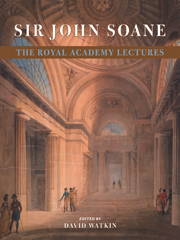Lecture V
from The Royal Academy Lectures
Published online by Cambridge University Press: 12 October 2018
Summary
MR. PRESIDENT, - The rise, progress, and meridian splendour of architecture, and likewise its decline until the time of Diocletian, having been traced in the preceding discourses, I shall now briefly show its further declension from the accession of Constantine till the knowledge of this noble art, as perfected by the Greeks and sometimes successfully imitated by the Romans, was completely obscured.
Constantine, having defeated his rival Maxentius, openly declared himself a proselyte to Christianity and, having no weak feelings for established opinions, resolved to root out every vestige of those pagan principles upon which the mighty fabric of Roman greatness had been raised.
The death of Maxentius afforded Constantine full leisure for such a purpose, and the zeal of Constantine began to manifest itself more decidedly by his converting many of the temples of paganism into places of devotion for the exercise of the new religion. His zeal afterwards shone with an increased lustre, as it was evinced by the entire demolition of many of the most superb monuments of the heathen world. Even the magnificent Mausoleum of Hadrian was stripped of its beautiful columns to decorate the church of San Paolo fuori Ie Mura which, from its resemblance in form and proportion to the basilicas of the ancients, was called the Basilica of St. Paul.
The Temple of Venus at Jerusalem was likewise destroyed, it being supposed that our Saviour had been buried under that very spot; and on that sacred ground, so far as expense could command, a magnificent church was erected. The drawings of this edifice, copied from Le Brun, show the degraded state of the arts at that period (pI. 8).
The church of Sta Sophia at Constantinople, erected by Justinian about the middle of the sixth century, is another striking example of the rapid decline of architecture and the arts connected therewith. The plan of this celebrated structure is, however, grandly conceived, although the execution and taste in the finishing is very defective and little calculated to satisfY our expectations.
On the completion of this mighty edifice, executed to rival the great works of antiquity, the emperor, who had constantly superintended its progress, was so astonished at contemplating its magnitude and so dazzled with its splendid decorations that he repeatedly exclaimed with ecstatic delight: ‘This surpasses the Temple of Solomon.'
- Type
- Chapter
- Information
- Sir John Soane: The Royal Academy Lectures , pp. 116 - 136Publisher: Cambridge University PressPrint publication year: 2000



